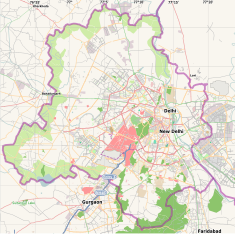| Red Fort | |
|---|---|
 A view of the Red Fort's Lahori Gate | |
| Location | Old Delhi, Delhi, India |
| Coordinates | 28°39′21″N 77°14′27″E / 28.65583°N 77.24083°E |
| Height | 18–33 m (59–108 ft) |
| Built | 12 May 1639 – 6 April 1648 |
| Built for | Mughal Empire |
| Architect | Ustad Ahmad Lahori |
| Architectural style(s) | Indo-Islamic architecture |
| Owner |
|
| Official name | Red Fort Complex |
| Type | Cultural |
| Criteria | ii, iii, vi |
| Designated | 2007 (31st session) |
| Reference no. | 231rev |
| Region | Indo-Pacific |
The Red Fort, also known as Lal Qila (Hindustani: [laːl qiːlaː]) is a historic Mughal fort in Delhi, India, that served as the primary residence of the Mughal emperors. Emperor Shah Jahan commissioned the construction of the Red Fort on May 12, 1639, following his decision to relocate the Mughal capital from Agra to Delhi. Originally adorned in red and white, the fort's design is attributed to Ustad Ahmad Lahori, the architect behind the Taj Mahal. The Red Fort represents the pinnacle of Mughal architecture during Shah Jahan's reign, blending Persian palace influences with indigenous Indian architectural traditions.
The fort was plundered and stripped of its artwork and jewels during Nadir Shah's invasion of the Mughal Empire in 1739. Most of the fort's marble structures were subsequently demolished by the British following the Indian Rebellion of 1857. The fort's defensive walls were largely undamaged, and the fortress was subsequently used as a garrison.
On 15 August 1947, the first Prime Minister of India, Jawaharlal Nehru, raised the Indian flag above the Lahori Gate. On India's Independence Day, observed annually on August 15, the Prime Minister ceremonially raises the Indian tricolour flag at the main gate of the historic fort and delivers a nationally broadcast address from its ramparts.
The Red Fort, as part of the Red Fort Complex, was recognized as a UNESCO World Heritage Site in 2007.[1][2]
- ^ "Red Fort Complex". World Heritage List. UNESCO World Heritage Centre. Archived from the original on 3 August 2009. Retrieved 15 November 2009.
- ^ "Red Fort was designated a UNESCO World Heritage Site in 2007". Lonely Planet. Archived from the original on 29 April 2012. Retrieved 4 August 2012.
